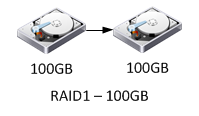RAID0 stripes disks together to appear as a single disk with a capacity equal to the sum of all the disks in the set. RAID0 provides excellent performance and capacity efficiency, but offers no data protection. If a disk fails in a RAID0 set, the data is lost and must be recovered from a backup or some other source. Since this level offers no redundancy, it is not a good choice for production or mission-critical storage.
The following diagram illustrates the disks in a RAID0 configuration:

RAID1 duplicates or mirrors data from one disk to another. A RAID1 set consists of two disks and data is written on both the disks, which can then be read from either disk. If one of the disks fails, the mirror can be rebuilt by replacing the disk. The following diagram illustrates disks in a RAID1 configuration:

RAID1+0, RAID1/0, or RAID10 is a stripe of multiple mirrors. RAID10 provides excellent redundancy and performance, making this the best option for mission-critical applications. RAID10 is well-suited for applications with small, random, write-intensive IOs, such as high transaction applications, large messaging applications, or large transactional database applications. A RAID10 set can recover from multiple drive failures, as long as two drives in the same mirror set do not fail.
Both RAID1 and RAID10 have a capacity efficiency of 50 percent, since half of the disks in a RAID1 or RAID10 set are used to store the mirrored data. The following diagram illustrates disks in a RAID10 configuration:

In RAID5, data is striped across several drives and parity is written equally across all the drives in the set. This parity allows for recovery from a failure of a single drive in the set. This level offers a balance of performance and capacity and is suitable for storing transactional databases, web servers, application servers, file servers, and mail servers. The following diagram illustrates disks in a RAID5 configuration:

The capacity efficiency of a RAID5 set is calculated using the formula [(n - 1) / n] * 100, where n is equal to the number of disks in the set. For example, a RAID5 set containing four 100 GB disks would provide 75 percent of the total capacity, or 300 GB:
[(4-1)/4]*100 = 75%
(100GB * 4) * .75 = 300GB
RAID6 is similar to RAID5, except that the two parity blocks are written and distributed equally across all the drives in the set. The second parity increases the write penalty but protects against two drive failures in the set. File archiving and file servers are common workloads that are hosted on RAID6.
The capacity efficiency of a RAID6 set is calculated using the formula [(n - 2) / n] * 100, where n is equal to the number of disks in the set. A RAID6 set containing six 100 GB disks would provide approximately 67 percent of the total capacity, or 400 GB:
[(6 - 2) / 6] * 100 = ~67%
(100GB * 6) * .67 = ~400GB
